The Portland Tribune published an article yesterday with a scary headline: “Car exhaust proves unseen road hazard.” The story chronicled the efforts of transportation researcher Alex Bigazzi, who rides around Portland with special equipment attached to his bike in order to measure air quality.
Bigazzi is a doctoral student at Portland State University who’s no stranger to this topic. In 2010, we wrote about research he worked on that pointed to the air quality and health benefits of streets that have cycle paths separated from auto traffic. Bigazzi’s latest work, as highlighted in the Tribune, are sure to raise some eyebrows. Here’s one of the opening paragraphs:
You might want to stay off Southeast Powell Boulevard if you’re a bike rider — Bigazzi’s breakthrough data shows biking on Powell leaves a rider with two to three times more volatile organic compounds in their lungs as a ride on a less-trafficked neighborhood bikeway route such as Southeast Clinton or Lincoln streets.
This concept isn’t new. In 2011, we shared a bit of research from Canada that showed how cycling in heavy traffic could have a “significant impact” on heart health due to exposure to air pollution.
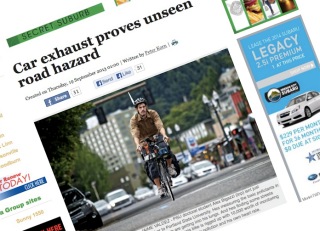
While the quality of the air we breathe is obviously an issue everyone cares about, the framing of the article in the Tribune has sparked a separated (yet related) debate: Is poor air quality on arterials a good reason for people to stop riding on them? Many people (including PBOT to some degree) strongly advocate that bicycle users should always use side streets when moving around town. On the other hand, other people resist that suggestion because they are comfortable riding on arterials (like Sandy for instance) and enjoy the convenience and access to destinations they provide.
The Tribune article spurred local citizen activist Doug Klotz to write on a local email list, “I suspect this was intended to be, and will be, used against any call for bike facilities on major streets.”
Bigazzi himself has also chimed in on the email thread. “My research does not address where the city should invest in bike infrastructure, or how road space should be allocated to reduce exposure for everyone,” he wrote. “If someone wanted to use my results to argue against providing space for bikes on arterials, they would have to consider how different bicycle infrastructure affects bicycle travel, auto travel volumes, and traffic patterns – which is a whole other area of research.”
Bigazzi continued: “That said, if you are a traveler, and trying to avoid air pollution, these results can provide information to help inform route choice decisions within the constraints of existing conditions.”
Another thing to consider when thinking about biking and auto exhaust is that air filters in cars don’t block pollutants. The reason this is a bigger deal for bicycle operators is that they breath harder than auto users and therefore the “intake and uptake rates of the pollutants are higher,” Bigazzi writes.
And of course, while the Tribune story goes into detail about the terrible things the toxic exhaust from cars can do to your body, it doesn’t mention the myriad health benefits of using a human-powered vehicle. When weighed against pollution intake, the physical benefits of riding outweigh the negative impacts of bad air quality.
Our reaction to this story and research shouldn’t be, “Bicycle riders should stay off arterials!”. It should be, why do we have streets where road users are forced to operate their vehicles mere feet from other vehicles that are spewing toxic chemicals into the air? Given that Transportation Commissioner Steve Novick is such an advocate of public health and bicycling, it appears he could use this research as yet another strong argument for doing more road diet projects, implementing more policies to discourage auto use in the central city, and building more cycle tracks separated from auto traffic on major streets.
In the meantime, we’re still holding our breath.
Read more about Alex Bigazzi’s research and his rolling bike laboratory at PortlandTribune.com.


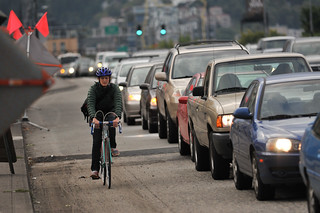
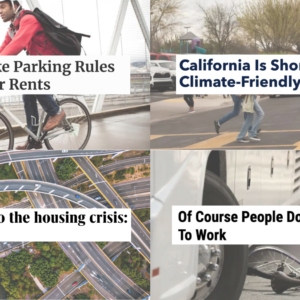

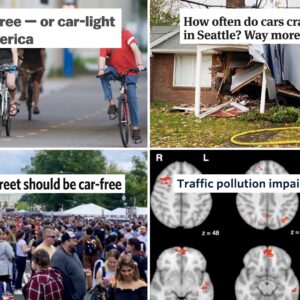
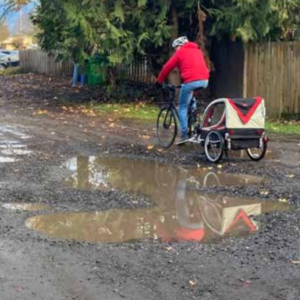
Thanks for reading.
BikePortland has served this community with independent community journalism since 2005. We rely on subscriptions from readers like you to survive. Your financial support is vital in keeping this valuable resource alive and well.
Please subscribe today to strengthen and expand our work.
Re-allocating road space for cycletracks and buffered bike lanes on arterials for retail access and commuters should be done and we should have a complete network of connected routes. Between limiteding the number of vehicles and new pollution control/ electric cars exhaust will continue to decrease over time like it has since the 70s.
But, for those who already are prone to brething problems or just want to avoid the exhaust, there should ALSO be an integrated residential greenway network even if it tends to be less direct sometimes.
How about this headline “Dangerous to Shop on Busy Streets”, since pedestrians that frequent businesses along arterials have to breath the same pollution? Enlist the businesses to help the cause.
Some people live near those arterials, and moving isn’t necessarily and option.
I’d like to see Salem come up with stronger protections and restrictions against harmful emissions.
Absolutely….I have lived on my high crash corridor for a decade….luckily the NW breeze clears things out most of the time after the evening commute. The new feul economy standards should have a sigificant effect over the next decade but we should do much better.
Additionally, most of the new residential developments in Portland have been occurring along arterial and major neighborhood streets, where traffic volumes are higher.
You could argue that compared to SF or Seattle, it is likely we have better air quality, but still. Something to consider…
Improving air quality will not just help people who bicycle, but also people who live in PDX.
actually, multnomah county has the worst air quality in the U.S. for people with respiratory illnesses according to the EPA. http://times.org/2011/01/05/map-of-toxic-air-in-portland-2/
Who knew? Thanks for the link.
But w/r/t this article here, it is worth noting that
“The model does not consider pollution from traffic.”
It would be interesting to overlay the car-caused air toxics onto this map, because the I-205 corridor has some of the best air quality in the city by the criteria of the map you linked to. Hm.
ok, I’m ready…
I always wondered why exhaust pipes on cars predominantly point towards the bike lanes and sidewalks. You would think if a buffered bike lane could provide that much more clean air, aiming the exhaust towards the middle of the road would provide similar benefits.
European cars (with single exhausts) are primarily on the left (drivers) side.
It is a great argument against driving on major roads. Drivers, as they are in the middle of traffic are exposed to higher levels of pollution than cyclists at the edge of the street.
Separated bike lanes as they increase the distance from traffic, signicantly decrease cyclist exposure to pollution. More space is also created between pedestrians and traffic decreasing their exposure to pollution.
Separated bike lanes also make it more likely that many people will cycle slower as they don’t have pressure from drivers behind them to cycle faster.
Lastly, by encouraging more people to cycle instead of driving, separated bike lanes decrease everyone’s exposure to pollution.
I doubt the difference between an exhaust port on the left versus the right is significant. The next car stirs the air as it whips by.
diffusion from a point source has an inverse exponential relationship to distance.
It seems to me to be a great argument against driving at all, and highlights (as Peter W points out) the collateral damage suffered by those who live on arterials, as I do, or those who practice at school athletic facilities on arterials, or those who play in playgrounds on arterials. Another case against car-centric urban planning, in my book!
Exactly. The only conclusion I see from this study is that we need to either enact policies that clean up auto emissions, or enact policies that discourage driving in general. Don’t treat the symptoms, treat the problem.
Mobile source pollution has been reduced tremendously over the years. Cars emit far less than they used to and are constantly getting cleaner. Ironically, you can thank the Clean Air Act amendment of 1990 (Bush Sr) for starting that trend.
And if you are going to point out costs, you should also point out benefits. You make it sound as if there are no positive economic impacts from driving. I suspect that is not the case – people would not drive is there were not individual benefit derived from the activity.
Also, your view is simply myopic. Perhaps your lifestyle affords you the ability to bike to work….many people do not have such luxury.
You can draw simple conclusions based upon a simple study, but that hardly encompasses the bigger picture.
“people would not drive is there were not individual benefit derived from the activity”
people drive because there is no alternative. massive anti-competitive subsidization of one transportation mode is not a rational actor free market.
MOTRG:
“Mobile source pollution has been reduced tremendously over the years. Cars emit far less than they used to and are constantly getting cleaner.”
You are (almost) correct. What you said is true for well-tuned, new cars. We have a heck of a lot of cars on the road that do not fall within either group.
“And if you are going to point out costs, you should also point out benefits. You make it sound as if there are no positive economic impacts from driving.”
Who was talking about economics? I thought this was about health.
“Also, your view is simply myopic. Perhaps your lifestyle affords you the ability to bike to work….many people do not have such luxury.”
Alice meets Dormouse.
Health ‘costs’ are economic.
On a semi-related note —
So you have seen the before/after pictures of lifelong smokers see the accelerated external effect it has on their bodies (nevermind the inside of their lungs).
I am wondering if long time bikers here have noticed the same kind of accelerated wear on their bodies or is more than offset by the healthy effects? I’m thinking of those folks that are getting at least an hour of road exposure a day.
Direct ingestion of smoke is far worse than breathing in ambient pollution.
Yeah, well. Unless you’re outside a Greyhound bus station or a fire fighter I’ve found it to be pretty easy to avoid direct ingestion of smoke. Less easy to avoid car exhaust if you’re someone who likes to bike around town.
Yes, but the amounts are still far less. All depends on how much time you spend in traffic, whether those cars are idling, etc. Many factors at work.
Police that spend most of their day driving, and professional truck drivers, also have shown a statistically significant increased incidence of respiratory carcinomas versus the general population.
Wish I could dig up the specific study; it was the only way to convince my military unit that cranking up 20+ big rigs inside a closed building was not just unpleasant but actually unhealthy and very unsafe.
Here’s one about truck drivers; there have been several such studies. This one happens to be freely available online, http://www.ncbi.nlm.nih.gov/pmc/articles/PMC2569090/.
Garshick, E., Laden, F., Hart, J. E., Rosner, B., Davis, M. E., Eisen, E. A., & Smith, T. J. (2008). Lung Cancer and Vehicle Exhaust in Trucking Industry Workers. Environmental Health Perspectives, 116(10), 1327-1332.
This is why I would be reluctant to use a cycle path in Sullivan’s Gulch. Convenient but deadly.
cars stink 🙂 wonder if i can go after the gas companies regarding my lungs
read up on what happened to Huey Long before considering going after the gas companies….
This is a very good reason to not promote a massive freeway expansion (CRC!) through our downtown. If anything, I-5 should be reduced, speed limits lowered and more/slower connections made to it from the city’s grid. 205 could be expanded, but only for freight. Why does Portland want to expand an Interstate right through the very heart of its downtown? Why is moving freight from Seattle to LA a compelling reason for this? We have too many SOV commuters, we should be actively DISCOURAGING them, not accommodating them! Change the designation of I-5 to the 205 route, and let I-5 start evolving into a local arterial.
I suspect that is easy to say if you don’t use the infrastructure regularly.
Now, imagine those people who are stuck for over an hour a day on the I- bridge…thinking “why do we spend all that money on bike stuff I don’t use when it could be used to make my own personal trip easier”?
Most of the toxins come from a tiny slice of the vehicles. More on-road detection and enforcement of emissions standards would improve air quality citywide. I can’t figure out why this isn’t common practice.
Wow- getting the worst polluters off the road is a no-brainer. Which types of vehicles are the worst? Old? Poorly maintained? I would think there is a fair, cost-effective solution for the high emissions vehicles.
Why aren’t they caught at DMV when they renew?
Why do unlicensed, uninsured drivers still drive? They have to – or they think they have to. Owners of highly toxic vehicles have places to be, and we make it as hard as possible to get there without their cars.
In Portland at least there are options. If someone can not afford to properly maintain their vehicle they either need to change their mode of transport or change their needed locations. Putting others at risk either through pollution or accident risk due to poor condition is not a fair option. The days of everyone being able to afford an auto are gone, everyone needs to adjust.
I would argue that any car older than 1975 is VERY well maintained. It may not adhere to the pollution standards of today, but that is not necessarily a far standard.
Heck, a lawn mower produces far more pollution than a car built today.
or a kewl 2-stroke vespa…
The list of exceptions is mind-boggling: any car older than 1975, etc http://www.oregon.gov/ODOT/DMV/pages/vehicle/emissions.aspx
Maybe cleaning up these rules would be a good start.
What all those hideous mopeds hipsters ride? Ok mpg, but they all spew exhaust!
In SF they sweep the street completely once a week. It requires everyone to move their cars or get towed. If Portland did this once a month at least, not only would we get cleaner street (for those with paved ones) but get some of the clunkers off the road. The city tows them away and if you can not afford to get it back since it sat for too long becuase of needed repairs…another old toxic car taken off the streets.
On the other hand, you have a clunker starting up frequently and most emissions from a car are from a cold start.
Particulates have the largest negative impact on health (lung cancer, CVD) and levels have not dropped much:
http://www.epa.gov/cgi-bin/broker?_service=data&_server=134.67.99.149&_port=4072&_sessionid=/ZBFx0ytbH.&_program=replay&_entry=apswork.x0000180.gplot.GIF
http://www.epa.gov/cgi-bin/broker?_service=data&_server=134.67.99.149&_port=4076&_sessionid=/ZBFx0yvxE4&_program=replay&_entry=apswork.x0000267.gplot.GIF
I believe that inhalation of vehicle exhaust is the single largest health risk I face. It’s time to make motorists pay for their deadly emissions.
Are there any cheap facemasks that would mitigate exposures for folks on bikes? I see many people in Japan, China, Korea wearing masks, but for them its more of a superstition against germs.
There are facemasks that filter out pollution but they are hard to breathe through and expensive to use as the filters need frequent replacing. I tried one a few years ago and found it severely wanting. Now I can’t use one because I wear a full-face helmet when I ride (it ain’t much to look at but I would prefer keeping my face in the same location on my head should I get hit again).
I feel that to be balanced, this article should also consider the substantial environmental impact of a flatulent cyclist after a loaded burrito. I’d take Powell over following one of those guys up Lincoln.
I’m changing my moniker to mr fartypants.
Finally, one of my pet peeves is a subject for discussion. My daily route includes Willamette Blvd, Greeley Ave, and Interstate Ave. I can often tell an older vintage auto by its smell – yuck! UPS trucks spew diesel fumes down low into my lungs. City buses have rooftop exhaust – thank you. Over the years, my daily winter riding post-nasal symptoms have worsened, and are especially bad when traffic is heavy. I now typically hack and spit my way to work and back. You’ll see my trail of snot on the roadway. I just wish they would just build the damn bike path from St. Johns Bridge to Steel Bridge so I can stay away from the fumes. I’ve been tempted to post a sign on my bike “Caution: Lungs at work – filtering your engine crap” or “Cars Stink!”, but then I figured that would probably only succeed in inciting a road rage incident. Just trying to do the right thing and survive. Cough! Cough!
I agree. Air quality in N. Portland is the worst in town. And it can be summed up in one word: diesel. City needs to mandate Port of Portland to phase out all of those old, stinking container haul trucks working the daily haul in/out of T6 and the variou railway yards around town. It’s where old trucks come to not retire, but pollute for another 20 years. Add that all of the trains and ships, and the diesel exhuast is pretty bad – much worse if you are behind one of these going up the hill on Interstate… Focus on the 5% of bad polluters.
To build off of Bigazzi’s research, I’d like to see some further investigation into how the amount of physical separation affects air quality. How do cyclists fare with plain bike lane, versus a 3-foot painted buffered bike lane, versus a 5-foot planting strip or a lane of parked cars between them and the car travel lanes?
If increasing distance from cars (even by a few feet) significantly improves air quality for cyclists, that makes a good case for providing more physically separated infrastructure on arterials rather than eliminating access. Or maybe that distance is so small that it doesn’t make any difference.
There’s already some recent research on this in New Zealand by a colleague of mine – see http://www.nzta.govt.nz/resources/research/reports/457/. They tested emission levels while riding on a normal on-road bike lane, behind parked cars on a footpath, and further back on an adjacent park pathway. Even moving to the other side of parked cars had quite a significant reduction in pollution exposure by people riding.
Awesome – Thanks, GlenK. So maybe that study, combined with this recent research, helps make the case for why more physical and spatial separation for bike facilities on arterials is needed.
Yes, if the research supports improvements in air quality over just a few feet of separation, seems to be an easy argument and relatively low-cost change to mount, or at least point, exhaust pipes toward the inside of the roadway lane, and for larger box vehicles like trucks and buses, somewhat upward facing if possible. In the US, then, that would be to mount pipes on the back left, pointing to the left. Make the drivers suck it up rather than bikes and peds. Mounting pipes on the topside of a large box-shaped vehicle also diffuses pollutants into a larger mass of air before they settle back down into the ‘lungway’. And, of course, if a few feet of separation makes a big difference, there is yet another bullet point for separated facilities.
And what is up with the NoPo industrial stench several whole days this last week? We have called the EPA numerous times in the past, and they claim that they don’t have the testing equipment and staff to measure these emissions in time – which must be coming from Swan Island or surrounding the peninsula – and therefore can’t catch the REALLY BIG gross polluters, far outweighing auto exhaust, scofflaw factories that cheat on their emissions regulations.
Having ridden through that stench, I believe it’s coming from the huge tank farms across the river from Swan Island. These tanks store petroleum products, and it’s very likely they are being vented, perhaps at levels above their permits. Or perhaps DEQ, doing the bidding of the industries, has recently increased their allowable emissions. The Sunday Oregonian had a front page story showing the locations of these tank farms, and the largest is right across from Swan Island and the U of P.
At UP, we have been told the stench comes either from Daimler if it’s a paint smell or Vigor Marine if it’s a sickeningly sweet-ish smell. But I have also had a petroleum smell in my office.
Robert, Don’t know if you meant to say you called DEQ – our state regulatory authority. A better bet. EPA doesn’t have a mechanism to address odor complaints. The state should – though rarely does. We are working on that. One way that would greatly assist our advocacy efforts is if you reported odors on our website: http://www.whatsinourair.org. We can map them and triangulate the data with windspeed/direction info as well as our knowledge of the industrial polluters in the area and get an idea from whence the stench comes. Your report via our website does go to DEQ as well. Thanks!
-mary
You are deluded if you think it will get any better in our lifetime. I will probably suck exhaust from highway 30 for the rest of my god-given days, no matter which manner of transport I use, even if I just sit here at my house 24/7. {that is until I get my “above the stench” hot-air balloon company going( it’ll be so… PORTLANDY!)} . At least when I bicycle while doing it, my smugness gets a workout in tandem with my body.
It has already gotten better in my lifetime. When I was a kid, ALL cars were pretty foul, not just the few poorly maintained ones. Nothing like riding at a training pace and having a monoxide belcher slow down in front of you instead of driving past cleanly — in about a second, you’re ready to barf your guts up.
Separated bicycle infrastructure should include two lanes on each side of the arterial; this would allow riders to almost always be upwind of the pollution source.
One of the major causes for all this pollution are older motor vehicles, not just the concentration of them. Older vehicles that don’t burn fuel efficiently (like the old stalling Datsun) will pump out many times the rate of pollution of newer cars.
The ‘clunkers for cash’ (or whatever its called) program has helped take a lot of older cars off the road. Still, Japan (with its high bicycling rate of the general public) has for many years mandated the removal of older vehicles from their roads. The US might do well to follow their lead and replace all cars with newer model Toyotas and Hondas (LEVs) instead of those big trucks and souped up vintage muscle cars I’m seeing all over southeast Portland these days (big-block V-8s cruising down Hawthorne and Belmont).
This would be my vision for Hawthorne to deal with poor cycling access and cutting down on traffic:
http://streetmix.net/-/55341
Yeah. That’ll be happening, just as soon as every yahoo with a classic-car boner has an abrupt heart attack and every NASCAR track simultaneously bursts into flames, emitting a steady stream of electric-assist bicycle subsidies and Amsterdam-style cycletracks into the right lane of every arterial road.
Sometimes we need to drive. I appreciate my clunker when I need it. It may not burn as clean as a Prius, but I’m reasonably certain that if it’s only being driven 100 miles per month, it’s annual emissions are lower than any Hybrid at 12k miles per year.
I just took my rarely-driven 1985 Toyota through DEQ, and it passed quickly and easily. My impression every time I start it is that it stinks and spews horribly. They/we are not caught at DEQ because the emissions standards are not very restrictive.
DEQ only tests vehicles newer than 1975, and cars outside of the Portland and Medford areas aren’t tested at all. Ie, if you live in Salem or Woodburn, your car has never been DEQ tested.
Having worked at the North Portland DEQ emissions station for 3 years, let me hazard an explanation:
Many vehicles are heavy polluters until they warm up. Important parts of the emission control system do not function (O2 sensor for example) until the engine has had time to heat up. When the system has heated up, the engine self-regulates to produce a lean/rich gas/air mixture which will minimize pollution. A good reason to warm up your vehicle in your own driveway, maybe, if you care about exposing others to your stinky spewing Toyota.
By the way, Toyotas usually do better than average on the emissions test, so there’s that too.
As a lover of old muscle cars, it pains me that I can smell them on my bike from 2 blocks away. I’d love to see a solution for pre-1975 cars that lets them stay on the road, and prevents them from spewing raw gasoline and other noxious fumes.
Tow them on a trailer, behind a Prius, Volt, Leaf, or Tesla?
People just need to learn to practice Effective Breathing, so they can ride with the cars in polluted air.
My understanding is the dirtier cars can be more than 100 times as polluting as the cleaner cars on the road. It only takes a handful of stinkers to ruin it for everyone. I do wish DEQ were authorized to clamp down more. The list of exceptions is huge, and it is costing us all in terms of health.
BTW, DEQ gives a “pass” to cars that meet the emissions standards that were in effect when the car was new, and the standards have been repeatedly raised over the years. So a 1990 car that passes may be a dozen times more polluting than a 2010 car.
Also … not only do cars pollute far, far more when they’re cold than when they’re warmed up (which is a good reason to do short trips by bike rather than by car), but due to incomplete combustion they also pollute a ton at idle. As I understand it the typical car actually generates more local pollutants when it’s parked and idling than it does blasting down the highway. Which is why I wish the mandatory no-idling zones at schools were better posted and enforced. And why it irks me to no end seeing people sitting in their parked cars running their engines.
aaronf
“A good reason to warm up your vehicle in your own driveway, maybe, if you care about exposing others to your stinky spewing Toyota.”
GlowBoy
“the typical car actually generates more local pollutants when it’s parked and idling than it does blasting down the highway.”
Both of you are correct. Which is why sarah gilbert wins the prize:
“It seems to me to be a great argument against driving at all.”
Also it is probably worth noting that the emissions under discussion have very little to do with fuel economy, or CO2, or climate change, but everything to do with incomplete combustion, so called criteria pollutants such as HC, SO2, NOx, particulates, and ozone.
http://www.epa.gov/air/urbanair/
Our laws have in fact had a huge effect on the former (per mile driven by newer cars), even if not so much on the latter.
So where can one find the standards that DEQ applies? I want numbers. As far as I can tell, their only age differentiation, once you’re required to be checked at all, is between cars that have inboard diagnostics and those that don’t. Is there a sliding scale of allowable pollution?
mh
“A good reason to warm up your vehicle in your own driveway, maybe, if you care about exposing others to your stinky spewing Toyota.” Not sure if that was meant as sarcasm, but warming up your car in the driveway is the WORST thing you can do in terms of pollution (not to mention fuel economy). It takes several times longer for your engine to warm up that way. Not a friendly thing to do to either your immediate or your regional neighbors. Best practice, by far, is to start it up and drive away immediately.
Dusting off one of my favorite books, Livable Streets by Appleyard…graphically showed how air and noise quality effects of MV traffic on where residents of arterial streets socially congregate…or no longer congregate.
Slowly abandoning their streets for the sidewalk, then retreating to front rooms and then finally rear rooms or moving away and renting their homes to others with less housing choice.
http://worldstreets.files.wordpress.com/2011/06/appleyard-graphc-light-traffic.jpg
http://worldstreets.files.wordpress.com/2011/06/appleyard-graphc-heavy-traffic.jpg
http://safestreetstrategies.wordpress.com/2011/12/20/defining-principles-remebering-donald-appleyard/
Jonathan, I think this latest research serves to inform the biking population about a potential hazard. With air quality advocacy, ignorance has been a huge barrier to effectively counter the arguments that this is just too tough a problem and the solutions to expensive to take on. I don’t think bike commuters should use a better understanding of the risk of bad air as reason not to ride, but instead a reason to show up and add their voice to the call for more health protective restrictions on air emissions. For example, our state has not adopted the stricter standards for diesel engines that make diesel pm2.5 our biggest health threat in the region, and one that puts cyclists specifically at greater risk. I hope that the cycling community will join the work to improve air quality in our urban core. OK – well join the advocacy work. People who choose alternatives to driving their cars are already making a huge contribution to improve air quality. It seems ironic that pedestrians and cyclists then bare a disproportionate burden of the bad air.
This issue seems like a great ballot measure. Who would vote for more toxic air pollution in their neighborhood? The proposition I’m imagining would hold ALL vehicles to the same standard, and that standard should be one we’d be comfortable having our children play around.
Has this been tried in the past? I’d be curious to see what the arguments in opposition were (and who fielded them.)
My nose knows when the engine of a car passing me hasn’t warmed up sufficiently for the car’s pollution controls to kick in.
Chris: There’s been opposition to auto exhaust emissions for close to 110 years. Some were members of the League of American Wheelmen, several thousand strong, that was founded May 30, 1880 when the bike of choice was the “Ordinary” and I don’t doubt that there were critical mass rides back then!
I was a smoker most of my life, finally got free just before 1/1/2000. I’ve been a bike commuter since 1979 when I was relocated by my employer to Albuquerque NM.
These days I cycle commute to my two volunteer jobs on two adjacent days each week, the Washco Community Bike Center in Hillsboro one day and then the Bicycle Transportation Alliance on the next day.
Being behind one of those small Trimet biodiesel buses is the worst!!!!! They will asphyxiate you!!!!
This thread is a good reminder that I’ve got to start riding home on the Ross Island bridge less often, despite the Hawthorne Bridge alternative adding as much as 3 miles to some of my routes. The Ross REALLY traps vehicle exhaust, probably due to the high concrete curbs and the concrete railings. And it carries a lot of trucks and buses
Good points being made about proximity to pollution abating the impacts. For my riding, it means I really search for a greenway for huff and puff climbs, but often times on the flat or downhill I simply opt for the faster (more air toxics) routes and take a few extra minutes to avoid super deep breaths of that not so good stuff. One issue I didn’t see mentioned yet is that the degree of abatement is different for say VOCs vs. particulate though–10 feet might drop some constituents, but others take hundreds of feet to abate. Many following this thread probably know there are a variety of chemicals in ‘grandfathered’ vehicles that meet old emissions standards, but the same is true for pre-2008 diesel engines grandfathered in–they can continue to run until the owner voluntarily takes them off the road. The difference between a gas and diesel engine? Grandfathered diesel engines are much longer lived–it’s far more likely you’ll be behind a 1995 diesel truck than a 1995 gas powered auto as time wears on in other words. Those older diesel engines pump out a lot of particulate (pm 2.5) that is a concern, and that abates with distance differently than chemicals in exhaust depending on level of traffic, wind, weather, etc. These engines can be retrofitted though to meet current standards! For more on the long slow “road” of getting these legacy diesels off the road (or retrofitted), see: http://www.epa.gov/diesel/ , health impacts of diesel exhaust: http://cfpub.epa.gov/ncea/cfm/recordisplay.cfm?deid=29060, and http://www.deq.state.or.us/aq/diesel/ (a lot of these particularly nasty pm 2.5 emitters are school buses–doesn’t hurt to talk to your school district about retrofits and if all else fails, at least idle reduction! It benefits the students subjected to fugitive exhaust, and every cyclist nearby.)
Thanks Jonathan and BikePortland for another great thought provoking article.